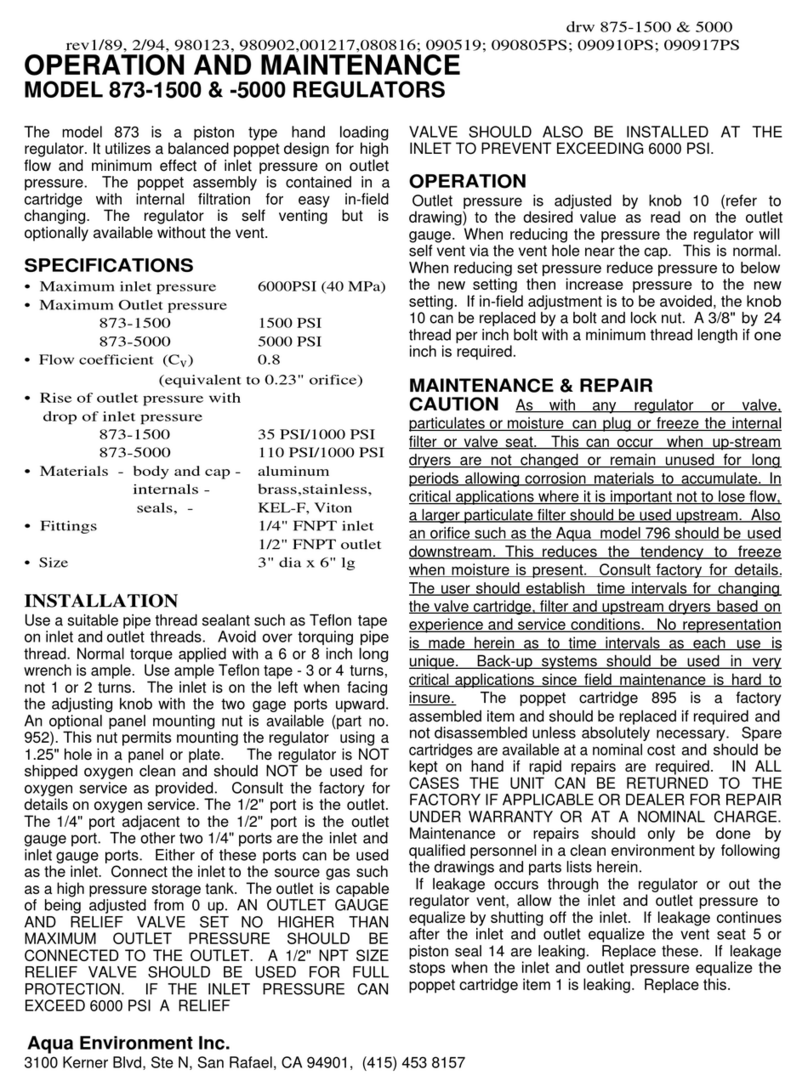
Aqua Environment Inc
drw 1121
2/96 980728; 061207; 090805PS
OPERATION AND MAINTENANCE
MODEL 1120 REGULATOR
GENERAL
The model 1120 is a small,
piston type, hand load
regulator
available in an outlet pressure range of 0 to
5000 PSI. Functionally it is similar to our model
415
-
5000 regulator but has only a single inlet and outlet
port. It is available with a hex head adjusting bolt
and
lock nut for single set pressure use or with the
same
adjusting hand
knob as used on the model 415
regulator. It can be
panel mounted using either the
upper 1.25" threaded section
and lock nuts (part
number 952) or the lower 1 inch jam nut.
It uses an
unbalanced poppet
design for ruggedness and
simplicity. There is a small variation of control
pressure
with changing inlet pressure as noted in the
specifications. A 20 to 30 micron filter in the
poppet
cartridge prevents damage by contaminants.
SPECIFICATIONS
Max inlet pressure 6000 PSI
Outlet pressure
0 to 5000 PSI
Body ports
1/4" MNPT - inlet at
the
bottom centerline
1/4" FNPT outlet on
the side as shown
Flow coefficient (Cv) .06 (equals .07" orifice)
Materials
anodized aluminum
body, brass and
stainless interiors
viton & KEL-F seals
Outlet pressure variation 70 PSI increase per
with inlet pressure
1000 PSI drop of inlet
ASSEMBLY PROCEDURE
1. Refer to the cross section
drawing and assemble in
clean dry area.
2. Blow all parts clean.
3. Inspect sealing
area of vent seat item 3 with 10X
magnification and remove any particles.
4. Install O ring 16 on piston 4.
5.
Completely pack area between cap 5 and piston 4
with
Cristo lub MCG 121 or 111 or equivalent.
Sufficient grease should be used
so it takes pressure
to extrude grease out as piston is inserted into
housing. Wipe off excess.
6.
Install O ring 17 with Dow 111 grease and install
seat item 3.
7. Install piston 4 assembly in cap 5.
8. Install cartridge 2 and O rings 18 &19 in body 1.
Lub
with Dow 111 grease.
9.
Install body 1 into cap 3. Insure seat 3 doesn't fall
out of place. Use Dow 11 on threads between body
and cap and torque to 3 to 15 ft lbs.
10. Apply Slick 50 or equivalent EP grease to
bearings 9 and 10 if used, screw
12 and threads in
cap 8.
x
11. Install spring guide 11, bearings 9 and 10,
spring
15, and spring guide 7 as shown.
12. Install cap
assembly onto regulator using mating
collar 6. Torque to 3 to 15 ft lbs.
11.
Install adjusting screw and knob or bolt and lock
nut items 12 and 13 using Slick 50 grease on
threads.
INSTALLATION
Use a suitable
pipe thread sealant such as teflon
tape on inlet and outlet threads. Avoid
over torquing
pipe thread. Normal torque applied
with a 6 or 8 inch
long wrench is ample. Use ample
teflon tape - 3 or 4
turns,
not 1 or 2 turns. The inlet is at the bottom of
the regulator as shown. The outlet is at the
side.
Optional panel mounting nuts are available (part
no.
952). These may be used to mount the regulator
through
a 1.25" panel hole. Optionally the regulator
can be mounted using the 1 inch jam nut and
body
flange shown near the bottom of the regulator.
The
regulator is NOT shipped oxygen clean and should
NOT be
used for oxygen service as provided.
Consult the factory for details on oxygen service.
AS
WITH
ANY REGULATOR, A RELIEF VALVE SET
SLIGHTLY ABOVE THE
MAXIMUM DESIRED
CONTROL PRESSURE SHOULD BE INSTALLED
ON THE OUTLET SIDE.
MAINTENANCE & REPAIR
CAUTION
As with any regulator or valve,
particulates or
moisture can plug or freeze the
internal filter
or valve seat. This can occur when up
-
stream dryers are
not changed or remain unused for
long
periods allowing corrosion materials to
accumulate. In
critical applications where it is
important not to lose flow, a larger
particulate filter
should be used
upstream. Also an orifice such as
the Aqua model 796 should be
used downstream.
This reduces the
tendency to freeze when moisture
is present. Consult factory for details.
The user
should establish time intervals for changing the
valve cartridge, filter and upstream
dryers based on
experience
and service conditions. No
representation is
made herein as to time intervals as
each use is unique. Back-up systems should be
used in very critical applications
since field
maintenance is
hard to insure. The poppet cartridge
832 is
a factory assembled item and should be
replaced if
required and not disassembled unless
absolutely necessary.
Spare cartridges are available
at a nominal cost and should be kept
on hand if rapid
repairs are required.
IN ALL CASES THE UNIT CAN
BE RETURNED
TO THE FACTORY OR DEALER
FOR
REPAIR UNDER WARRANTY IF APPLICABLE
OR AT A NOMINAL CHARGE. Maintenance
or
repairs should only be done
by qualified personnel
in a clean environment by following the drawings
herein.




















